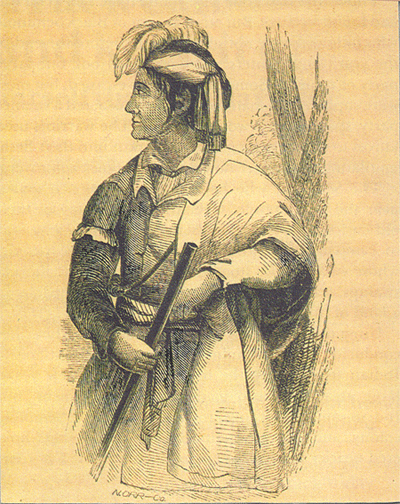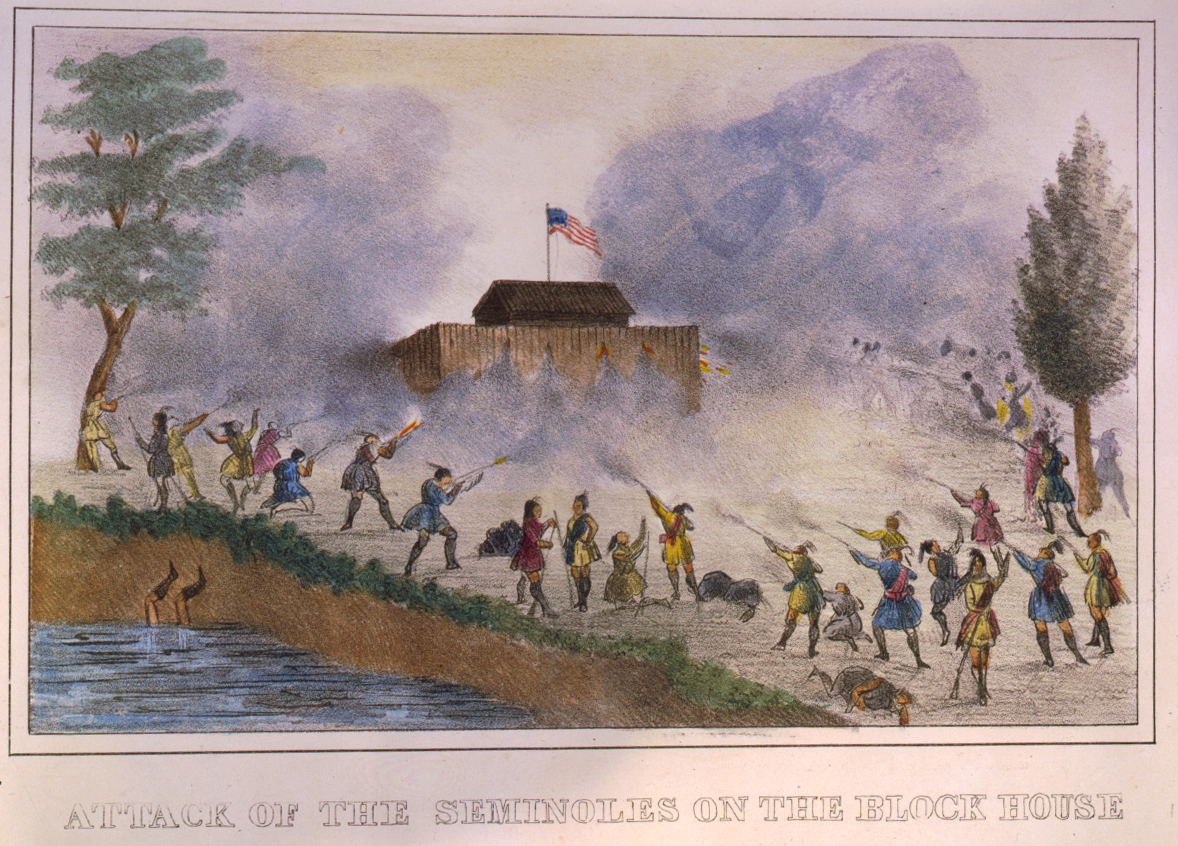|
Ee-mat-la
Ee-mat-la, also known as King Phillip, (9 October 1739 - 8 October 1839) was a Seminole chief during the Second Seminole War. He was captured while camped at Dunlawton plantation, and held at Fort Marion The Castillo de San Marcos (Spanish for "St. Mark's Castle") is the oldest masonry fort in the continental United States; it is located on the western shore of Matanzas Bay in the city of St. Augustine, Florida. It was designed by the Spanish .... He died while being transported west in 1839. He was "also a very aged chief, who has been a man of great notoriety and distinction in his time, but has now got too old for further warlike enterprize." His son was Coacoochee (Wild Cat). References External links''Ee-mat-la'', Catlin sketch, Ayer Art Digital Collection (Newberry Library) [...More Info...] [...Related Items...] OR: [Wikipedia] [Google] [Baidu] |
Ee-mat-la
Ee-mat-la, also known as King Phillip, (9 October 1739 - 8 October 1839) was a Seminole chief during the Second Seminole War. He was captured while camped at Dunlawton plantation, and held at Fort Marion The Castillo de San Marcos (Spanish for "St. Mark's Castle") is the oldest masonry fort in the continental United States; it is located on the western shore of Matanzas Bay in the city of St. Augustine, Florida. It was designed by the Spanish .... He died while being transported west in 1839. He was "also a very aged chief, who has been a man of great notoriety and distinction in his time, but has now got too old for further warlike enterprize." His son was Coacoochee (Wild Cat). References External links''Ee-mat-la'', Catlin sketch, Ayer Art Digital Collection (Newberry Library) [...More Info...] [...Related Items...] OR: [Wikipedia] [Google] [Baidu] |
Wild Cat (Seminole)
Wild Cat, also known as ''Coacoochee'' or ''Cowacoochee ''(from Creek ''Kowakkuce "''bobcat, wildcat''"') ''(c. 1807/1810–1857) was a leading Seminole chieftain during the later stages of the Second Seminole War and the nephew of Micanopy. Background Wild Cat's exact year and place of birth is not agreed upon. Many local scholars believe he was born in 1807 on an island in big Lake Tohopekaliga, south of present-day Orlando. Some scholars say Wild Cat was born around 1810 to King Philip (or Ee-mat-la) and his wife in Yulaka, a Seminole village along the St. Johns River in northern Florida. Still others suggest that he was born near present-day Apopka, Florida. Wild Cat may have had a twin sister who died at birth. As a twin, he was regarded by the tribe as being particularly gifted. As tensions mounted between the Seminole and local settlers following the purchase of Florida by the United States in 1821, the bands encouraged the escape of slaves from neighboring Georgia to di ... [...More Info...] [...Related Items...] OR: [Wikipedia] [Google] [Baidu] |
Fort Marion
The Castillo de San Marcos (Spanish for "St. Mark's Castle") is the oldest masonry fort in the continental United States; it is located on the western shore of Matanzas Bay in the city of St. Augustine, Florida. It was designed by the Spanish engineer Ignacio Daza, with construction beginning in 1672, 107 years after the city's founding by Spanish Admiral and conquistador Pedro Menéndez de Avilés, when Florida was part of the Spanish Empire. The fort's construction was ordered by Governor Francisco de la Guerra y de la Vega after a raid by the English privateer Robert Searles in 1668 that destroyed much of St. Augustine and damaged the existing wooden fort. Work proceeded under the administration of Guerra's successor, Manuel de Cendoya in 1671, and the first '' coquina'' stones were laid in 1672. The construction of the core of the current fortress was completed in 1695, though it would undergo many alterations and renovations over the centuries. Though built in part by bl ... [...More Info...] [...Related Items...] OR: [Wikipedia] [Google] [Baidu] |
Seminole
The Seminole are a Native American people who developed in Florida in the 18th century. Today, they live in Oklahoma and Florida, and comprise three federally recognized tribes: the Seminole Nation of Oklahoma, the Seminole Tribe of Florida, and the Miccosukee Tribe of Indians of Florida, as well as independent groups. The Seminole people emerged in a process of ethnogenesis from various Native American groups who settled in Spanish Florida beginning in the early 1700s, most significantly northern Muscogee Creeks from what is now Georgia and Alabama. The word "Seminole" is derived from the Muscogee word ''simanó-li''. This may have been adapted from the Spanish word ''cimarrón'', meaning "runaway" or "wild one". Seminole culture is largely derived from that of the Creek; the most important ceremony is the Green Corn Dance; other notable traditions include use of the black drink and ritual tobacco. As the Seminole adapted to Florida environs, they developed local traditions ... [...More Info...] [...Related Items...] OR: [Wikipedia] [Google] [Baidu] |
Tribal Chief
A tribal chief or chieftain is the leader of a tribal society or chiefdom. Tribe The concept of tribe is a broadly applied concept, based on tribal concepts of societies of western Afroeurasia. Tribal societies are sometimes categorized as an intermediate stage between the band society of the Paleolithic stage and civilization with centralized, super-regional government based in cities. Anthropologist Elman Service distinguishes two stages of tribal societies: simple societies organized by limited instances of social rank and prestige, and more stratified societies led by chieftains or tribal kings (chiefdoms). Stratified tribal societies led by tribal kings are thought to have flourished from the Neolithic stage into the Iron Age, albeit in competition with urban civilisations and empires beginning in the Bronze Age. In the case of tribal societies of indigenous peoples existing within larger colonial and post-colonial states, tribal chiefs may represent their tribe or ... [...More Info...] [...Related Items...] OR: [Wikipedia] [Google] [Baidu] |
Second Seminole War
The Second Seminole War, also known as the Florida War, was a conflict from 1835 to 1842 in Florida between the United States and groups collectively known as Seminoles, consisting of Native Americans in the United States, Native Americans and Black Indians in the United States, Black Indians. It was part of a series of conflicts called the Seminole Wars. The Second Seminole War, often referred to as ''the'' Seminole War, is regarded as "the longest and most costly of the American Indian Wars, Indian conflicts of the United States". After the Treaty of Payne's Landing in 1832 that called for the Seminole's removal from Florida, tensions rose until open hostilities started with Dade battle. For the next four years, the Seminole and the U.S. forces engaged in small engagements and by 1842 only a few hundred native peoples remained in Florida. The war was declared over on August 14, 1842. Background Bands from various tribes in the southeastern United States had moved into the uno ... [...More Info...] [...Related Items...] OR: [Wikipedia] [Google] [Baidu] |
Dunlawton Plantation And Sugar Mill
The Dunlawton Plantation and Sugar Mill, a 19th-century cane sugar plantation in north-central Florida, was destroyed by the Seminoles at the beginning of the Second Seminole War. The ruins are located at 950 Old Sugar Mill Road, Port Orange, Florida. On August 28, 1973, the site was added to the United States National Register of Historic Places under the title of Dunlawton Plantation-Sugar Mill Ruins. The ruins are now part of the Dunlawton Sugar Mill Gardens. The botanical gardens include interpretive signs about the enclosed ruins, large concrete sculptures of dinosaurs and a giant ground sloth, a gazebo, and plantings of grasses, flowers, bushes and native plants under a canopy of oak trees. History Plantation early years The Dunlawton Plantation and its sugar mill date to the latter years of the Second Spanish period in Florida. In August 1804, Patrick Dean, a merchant from the Bahamas, and his uncle John Bunch, a planter from Nassau, were granted by the Spanish Crown land ... [...More Info...] [...Related Items...] OR: [Wikipedia] [Google] [Baidu] |
Bruce E
The English language name Bruce arrived in Scotland with the Normans, from the place name Brix, Manche in Normandy, France, meaning "the willowlands". Initially promulgated via the descendants of king Robert the Bruce (1274−1329), it has been a Scottish surname since medieval times; it is now a common given name. The variant ''Lebrix'' and ''Le Brix'' are French variations of the surname. Actors * Bruce Bennett (1906–2007), American actor and athlete * Bruce Boxleitner (born 1950), American actor * Bruce Campbell (born 1958), American actor, director, writer, producer and author * Bruce Davison (born 1946), American actor and director * Bruce Dern (born 1936), American actor * Bruce Gray (1936–2017), American-Canadian actor * Bruce Greenwood (born 1956), Canadian actor and musician * Bruce Herbelin-Earle (born 1998), English-French actor and model * Bruce Jones (born 1953), English actor * Bruce Kirby (1925–2021), American actor * Bruce Lee (1940–1973), martial ... [...More Info...] [...Related Items...] OR: [Wikipedia] [Google] [Baidu] |
Donald A
Donald is a masculine given name derived from the Gaelic name ''Dòmhnall''.. This comes from the Proto-Celtic *''Dumno-ualos'' ("world-ruler" or "world-wielder"). The final -''d'' in ''Donald'' is partly derived from a misinterpretation of the Gaelic pronunciation by English speakers, and partly associated with the spelling of similar-sounding Germanic names, such as ''Ronald''. A short form of ''Donald'' is ''Don''. Pet forms of ''Donald'' include ''Donnie'' and ''Donny''. The feminine given name ''Donella'' is derived from ''Donald''. ''Donald'' has cognates in other Celtic languages: Modern Irish ''Dónal'' (anglicised as ''Donal'' and ''Donall'');. Scottish Gaelic ''Dòmhnall'', ''Domhnull'' and ''Dòmhnull''; Welsh '' Dyfnwal'' and Cumbric ''Dumnagual''. Although the feminine given name ''Donna'' is sometimes used as a feminine form of ''Donald'', the names are not etymologically related. Variations Kings and noblemen Domnall or Domhnall is the name of many ancie ... [...More Info...] [...Related Items...] OR: [Wikipedia] [Google] [Baidu] |
1739 Births
Events January–March * January 1 – Bouvet Island is discovered by French explorer Jean-Baptiste Charles Bouvet de Lozier, in the South Atlantic Ocean. * January 3: A 7.6 earthquake shakes the Ningxia Hui Autonomous Region in China killing 50,000 people. * February 24 – Battle of Karnal: The army of Iranian ruler Nader Shah defeats the forces of the Mughal emperor of India, Muhammad Shah. * March 20 – Nader Shah occupies Delhi, India and sacks the city, stealing the jewels of the Peacock Throne, including the Koh-i-Noor. April–June * April 7 – English highwayman Dick Turpin is executed by hanging for horse theft. * May 12 – John Wesley lays the foundation stone of the New Room, Bristol in England, the world's first Methodist meeting house. * June 13 – (June 2 Old Style); The Royal Swedish Academy of Sciences is founded in Stockholm, Sweden. July–September * July 9 – The first group purporting ... [...More Info...] [...Related Items...] OR: [Wikipedia] [Google] [Baidu] |
1839 Deaths
Events January–March * January 2 – The first photograph of the Moon is taken, by French photographer Louis Daguerre. * January 6 – Night of the Big Wind: Ireland is struck by the most damaging cyclone in 300 years. * January 9 – The French Academy of Sciences announces the daguerreotype photography process. * January 19 – British forces capture Aden. * January 20 – Battle of Yungay: Chile defeats the Peru–Bolivian Confederation, leading to the restoration of an independent Peru. * January – The first parallax measurement of the distance to Alpha Centauri is published by Thomas Henderson. * February 11 – The University of Missouri is established, becoming the first public university west of the Mississippi River. * February 24 – William Otis receives a patent for the steam shovel. * March 5 – Longwood University is founded in Farmville, Virginia. * March 7 – Baltimore City College, the third public high school in the United States, is esta ... [...More Info...] [...Related Items...] OR: [Wikipedia] [Google] [Baidu] |







